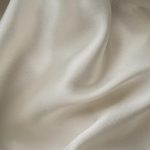Do you wonder if silk fabric makes you hot?
Understanding the breathability, insulating properties, and moisture-wicking abilities of silk can help you master the art of staying comfortable in warm weather.
By comparing silk with other fabrics and learning tips for wearing silk in hot conditions, you can make informed choices about your wardrobe.
Key Takeaways
- Silk fabric is highly breathable and allows for air circulation.
- Silk has the ability to wick away moisture from the skin and helps regulate body temperature.
- Silk is a natural insulator that can provide warmth in colder temperatures without overheating.
- Compared to other fabrics like polyester and cotton, silk is highly breathable, has natural moisture-wicking properties, and is more durable.
The Breathability of Silk Fabric
If you often feel hot and sweaty while wearing silk fabric, you may be surprised to learn that silk is actually highly breathable. Silk fabric has a remarkable ability to wick away moisture from your skin, allowing it to evaporate quickly. This process helps to keep you cool and dry, making silk a fantastic choice, even in warm weather.
The natural protein fibers in silk fabric have a unique structure that allows for air to circulate, creating a cooling effect. This breathability is one of the reasons why silk has been a popular choice for clothing in various climates for centuries.
When you wear silk, the fabric allows your body to regulate temperature more effectively, reducing the likelihood of feeling overheated and sweaty. Unlike synthetic materials, silk fabric is a natural and luxurious option that offers both comfort and style.
Insulating Properties of Silk
Silk isn't just a luxurious fabric; it's also a natural insulator that can help regulate your body temperature.
This means that silk can keep you warm in cooler temperatures and cool in warmer ones, making it a versatile option for year-round comfort.
Understanding the insulating properties of silk can help you make informed choices about your clothing and bedding, ensuring that you stay comfortable in any season.
Silk's Natural Insulation
You may not realize that silk fabric often provides excellent insulation, helping to regulate your body temperature in various climates. Here's why silk is a natural insulator:
- Breathability: Silk is breathable, allowing air to circulate and moisture to evaporate, which helps prevent the accumulation of sweat and keeps you cool.
- Heat retention: Silk fabric has natural heat retention properties, providing warmth in colder temperatures without overheating.
- Lightweight insulation: Silk's natural insulation capabilities allow it to provide warmth without the bulk, making it an ideal choice for layering in diverse weather conditions.
- Temperature regulation: Silk adapts to your body's temperature, keeping you comfortable in both warm and cool environments.
Silk's insulating properties make it a versatile fabric that can keep you comfortable year-round.
Regulating Body Temperature
As a result of its natural insulation capabilities, silk fabric effectively regulates your body temperature by allowing air to circulate while preventing overheating. Silk's thermoregulation benefits make it an ideal choice for maintaining comfort in various climates. Its heat management properties help in keeping you warm in cooler temperatures and cool in warmer conditions.
| Thermoregulation Benefits | Heat Management Properties |
|---|---|
| Regulates body temperature | Insulates in cooler temperatures |
| Allows air circulation | Prevents overheating |
| Maintains comfort in various climates | Helps in cooling in warmer conditions |
Silk's ability to insulate without causing overheating makes it a superior choice for those seeking mastery over their comfort. Whether you're in a warm or cool environment, silk fabric works with your body to maintain the ideal temperature.
Moisture-Wicking Abilities of Silk
When wearing silk fabric, you may notice its moisture-wicking abilities, which help keep you cool and dry. This luxurious material has natural properties that make it an excellent choice for managing moisture, making it ideal for those seeking comfort in various conditions.
Here's why silk is great at wicking away moisture:
- Absorption: Silk fabric is capable of absorbing moisture without making you feel damp, making it an excellent choice for managing sweat during physical activities or hot weather.
- Evaporation: The structure of silk allows moisture to evaporate quickly, preventing the fabric from clinging to your skin and keeping you feeling fresh.
- Breathability: Silk is breathable, allowing air to circulate and moisture to escape, promoting a cooling effect on your skin.
- Humidity Control: Silk fabric helps regulate humidity around your body, keeping you comfortable in varying environmental conditions.
With its ability to absorb, evaporate, and control humidity, silk fabric is an exceptional choice for those looking to stay cool and dry, making it a valuable addition to your wardrobe, especially during warmer seasons or high-intensity activities.
Silk Fabric and Temperature Regulation
Experiencing silk's temperature-regulating properties, you'll find it effectively managing your body's heat, ensuring comfort in various climates. Silk fabric has a remarkable ability to wick away moisture from your skin, keeping you dry and comfortable even during periods of increased physical activity or warm weather. This moisture-wicking attribute of silk helps in preventing the discomfort often associated with sweating, making it an excellent choice for those seeking a fabric that can adapt to their body's needs.
Additionally, silk fabric adjusts to the body's temperature, making it suitable for both hot and cold environments. In humid conditions, silk helps to maintain a comfortable level of dryness, preventing that sticky feeling often caused by excessive moisture in the air. This natural, breathable fabric allows for better air circulation, which aids in managing body temperature and reducing the effects of humidity.
Ultimately, silk fabric's temperature-regulating properties make it a versatile and practical choice for maintaining comfort in a range of climates and conditions.
Comparing Silk With Other Fabrics
You'll notice that silk fabric outperforms other fabrics in temperature regulation due to its moisture-wicking and breathable properties. When comparing silk with cotton and polyester, it's clear that silk stands out in terms of comfort and performance.
- Breathability: Silk is highly breathable, allowing air to circulate and body heat to escape, unlike polyester, which can trap heat and moisture against the skin.
- Moisture-Wicking: Silk has natural moisture-wicking properties, drawing perspiration away from the skin, while cotton tends to retain moisture, potentially causing discomfort.
- Temperature Regulation: Silk is an excellent insulator, helping to maintain a comfortable body temperature in various climates, unlike cotton, which may not provide adequate warmth in colder conditions.
- Durability: Silk is a strong and resilient fabric, outlasting polyester, which can wear out more quickly and retain odors.
Tips for Wearing Silk in Warm Weather
In warm weather, wearing silk requires choosing lightweight styles that promote airflow and comfort. To stay cool and stylish in silk during the summer, opt for loose-fitting silhouettes like flowy dresses, wide-leg pants, and breezy tops.
When it comes to silk care, always check the care label and follow the manufacturer's instructions, but generally, hand washing with a gentle detergent and air drying is the best way to maintain the fabric's quality. Additionally, consider wearing seamless or moisture-wicking undergarments to prevent any discomfort from sweat.
Embracing summer styling with silk also means choosing lighter colors that reflect rather than absorb sunlight, such as pastels or whites. These hues can help you stay cooler compared to darker shades.
Another tip for wearing silk in warm weather is to accessorize with breathable materials like straw hats, open-toed sandals, and lightweight scarves to complement your silk outfit.
Frequently Asked Questions
How Do I Properly Care for Silk Fabric to Maintain Its Breathability and Insulating Properties?
To properly care for silk fabric and maintain its breathability and insulating properties, gently hand wash in cold water with a mild detergent, then air dry. Avoid direct sunlight and heat. This will ensure its longevity and effectiveness.
Can Silk Fabric Be Worn in Hot and Humid Climates Without Causing Discomfort?
In hot and humid climates, silk fabric is breathable and can help regulate your body temperature. It's versatile for various clothing styles and can be layered with other materials for added insulation while maintaining comfort.
What Are the Best Types of Silk Fabric for Temperature Regulation in Different Climates?
For temperature regulation in different climates, silk fabric is fantastic. Proper care enhances its breathability and insulating properties, making it suitable for hot and humid climates. Choose lightweight silk and clothing styles that promote cooling effects to keep your body cool in warm weather.
Are There Any Specific Clothing Styles or Designs That Can Maximize the Cooling Effects of Silk Fabric in Warm Weather?
To maximize comfort in warm weather, explore silk blends and cooling fashion. Look for breathable care in clothing styles and designs. Silk fabric can be cool and comfortable when chosen wisely for hot climates.
Can Silk Fabric Be Layered With Other Materials to Enhance Its Ability to Keep the Body Cool in Hot Conditions?
Layering options with silk can enhance its cooling properties. Choosing breathable and lightweight materials like linen or cotton to layer with silk can help regulate body temperature in hot conditions, maximizing the cooling effect.
- Recycling Nonwoven Fabrics: Is It Possible? - July 11, 2025
- Recycling Nonwoven Fabrics: Is It Possible? - July 11, 2025
- Recycling Nonwoven Fabrics: Is It Possible? - July 11, 2025







